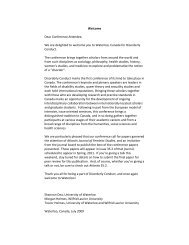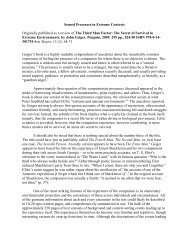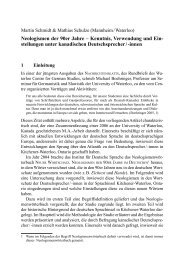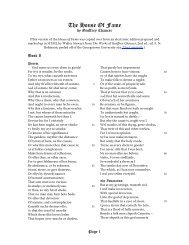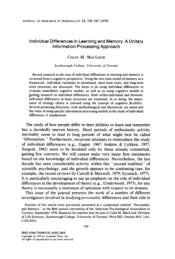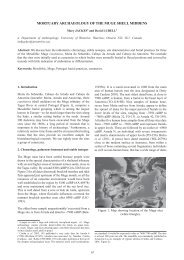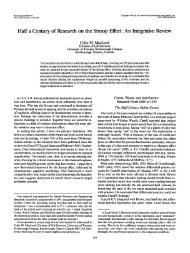The mid seventeenth century collapse of Iroquoian Ontario:
The mid seventeenth century collapse of Iroquoian Ontario:
The mid seventeenth century collapse of Iroquoian Ontario:
Create successful ePaper yourself
Turn your PDF publications into a flip-book with our unique Google optimized e-Paper software.
M. JackeS<br />
360<br />
such circumstances prevented a clear diagnosis in the early epidemics in New France. Oddly<br />
enough, Robert le Coq, a French layman, was so disfigured by smallpox, and his body, including<br />
his eyes, so covered with sores (tout chargé de playes et d’ulceres), that it was said to be<br />
“extraordinary” (JR, 19, p. 98-109). This was in 1640, suggesting that le Coq’s was a much<br />
more severe smallpox than previously seen by either the Huron or the Jesuits, and yet,<br />
though abandoned without shelter, starving and exposed to heavy rainfall, he survived to be<br />
killed in August 1650 (JR, 35, p. 53).<br />
Another disease lasted for many months in <strong>Ontario</strong> in 1636 and 1637, no doubt again<br />
exacerbated by previous malnourishment. <strong>The</strong>re was famine in the winter <strong>of</strong> 1634-1635,<br />
followed by drought and fires from Easter until <strong>mid</strong> June (JR, 10, p. 35).<br />
A smallpox epidemic began in 1638 in Boston and spread to <strong>Ontario</strong> in 1639 and 1640. <strong>The</strong><br />
Jesuits were again sometimes unable to identify it with any certainty (JR, 16, p. 53).<br />
Chaumonot (2002, p. 26) still referred to the 1639 epidemic as “a kind <strong>of</strong> smallpox” when he<br />
later wrote his autobiography and described his first year in New France.<br />
A case <strong>of</strong> smallpox?<br />
Fe 1/33 was a particularly interesting bundle burial in Feature 1 at Grimsby. <strong>The</strong> individual<br />
had abnormalities <strong>of</strong> both hips and <strong>of</strong> both elbows. <strong>The</strong> diagnosis (Jackes, 1983) is <strong>of</strong><br />
osteomyelitis variolosa, the disruption <strong>of</strong> the growing ends <strong>of</strong> long bones in children who<br />
have smallpox. While the age <strong>of</strong> Fe 1/33 is unknown (his skull was missing), he is likely to<br />
have been well into adulthood. <strong>The</strong> sternum and sacrum were both fused and the bones were<br />
osteoporotic. While age is uncertain in cases <strong>of</strong> pathology, Fe 1/33 must have contracted<br />
smallpox before 1639. <strong>The</strong> conclusion might be that the epidemic <strong>of</strong> 1634 was actually<br />
smallpox, or that smallpox had been present prior to any recorded epidemics (Jackes, 1983;<br />
1988). <strong>The</strong> simpler conclusion is that Fe 1/33 had contracted smallpox through the Seneca.<br />
Biased mortality?<br />
We cannot absolutely rely on the words <strong>of</strong> the Jesuit missionaries, but phrases like that <strong>of</strong><br />
Chaumonot in 1640 (JR, 18, p. 23), when he writes <strong>of</strong> a contagious illness which spares neither<br />
age nor sex and most <strong>of</strong>ten carries away young children (les petits enfants), give us indications<br />
<strong>of</strong> morbidity and mortality related to disease. <strong>The</strong> published text is translated into French<br />
from the original Italian, so without a check <strong>of</strong> the original there remains the possibility that<br />
he meant that those who could be baptized before death were mostly young children, but that<br />
reading seems unlikely. <strong>The</strong> passage suggests that the high adolescent mortality at Grimsby<br />
(see above) cannot be ascribed to the epidemics <strong>of</strong> the 1630s.<br />
It is justified to consider that the demographic bias in the IIIa burials is not caused by<br />
disease alone but by an influx <strong>of</strong> women and children. <strong>The</strong> glass bead frequencies in Feature<br />
could result in pellagra. It should be noted that periostitis and high rates <strong>of</strong> dental caries (particularly<br />
marked among females at Grimsby) are characteristic <strong>of</strong> <strong>Ontario</strong> <strong>Iroquoian</strong> skeletons (cf. Brenton, Paine,<br />
2007).



